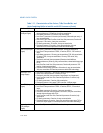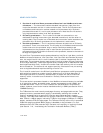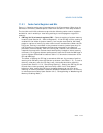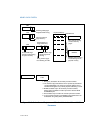
11-10 Vol. 3
MEMORY CACHE CONTROL
possible) and through to system memory. When writing through to memory,
invalid cache lines are never filled, and valid cache lines are either filled or inval-
idated. Write combining is allowed. This type of cache-control is appropriate for
frame buffers or when there are devices on the system bus that access system
memory, but do not perform snooping of memory accesses. It enforces
coherency between caches in the processors and system memory.
• Write-back (WB) — Writes and reads to and from system memory are cached.
Reads come from cache lines on cache hits; read misses cause cache fills.
Speculative reads are allowed. Write misses cause cache line fills (in processor
families starting with the P6 family processors), and writes are performed
entirely in the cache, when possible. Write combining is allowed. The write-back
memory type reduces bus traffic by eliminating many unnecessary writes to
system memory. Writes to a cache line are not immediately forwarded to system
memory; instead, they are accumulated in the cache. The modified cache lines
are written to system memory later, when a write-back operation is performed.
Write-back operations are triggered when cache lines need to be deallocated,
such as when new cache lines are being allocated in a cache that is already full.
They also are triggered by the mechanisms used to maintain cache consistency.
This type of cache-control provides the best performance, but it requires that all
devices that access system memory on the system bus be able to snoop memory
accesses to insure system memory and cache coherency.
• Write protected (WP) — Reads come from cache lines when possible, and read
misses cause cache fills. Writes are propagated to the system bus and cause
corresponding cache lines on all processors on the bus to be invalidated.
Speculative reads are allowed. This memory type is available in processor
families starting from the P6 family processors by programming the MTRRs (see
Table 11-6).
Table 11-3 shows which of these caching methods are available in the Pentium, P6
Family, Pentium 4, and Intel Xeon processors.
Table 11-3. Methods of Caching Available in Intel Core 2 Duo, Intel Atom, Intel Core
Duo, Pentium M, Pentium 4, Intel Xeon, P6 Family, and Pentium Processors
Memory Type Intel Core 2 Duo, Intel Atom, Intel
Core Duo, Pentium M, Pentium 4
and Intel Xeon Processors
P6 Family
Processors
Pentium
Processor
Strong Uncacheable (UC) Yes Yes Yes
Uncacheable (UC-) Yes Yes* No
Write Combining (WC) Yes Yes No
Write Through (WT) Yes Yes Yes
Write Back (WB) Yes Yes Yes
Write Protected (WP) Yes Yes No


















